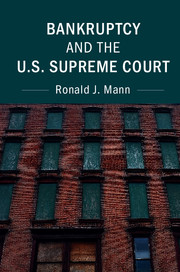Book contents
- Frontmatter
- Contents
- List of Figures
- List of Tables
- Preface
- Introduction
- PART I SETTING THE STAGE
- 1 Literature Review
- 2 Data and Methods
- 3 Congress and The Bankruptcy Code of 1978
- 4 By the Numbers
- PART II THE HARD CASES
- SECTION A MISSED OPPORTUNITIES: CONGRESS, THE COURT, AND THE BANKRUPTCY CLAUSE
- SECTION B INTERPRETIVE STRATEGY: THE COURT, THE SOLICITOR GENERAL, AND THE CODE
- PART III AMICI AND THE COURT
- PART IV CONCLUSION
3 - Congress and The Bankruptcy Code of 1978
from PART I - SETTING THE STAGE
Published online by Cambridge University Press: 04 May 2017
- Frontmatter
- Contents
- List of Figures
- List of Tables
- Preface
- Introduction
- PART I SETTING THE STAGE
- 1 Literature Review
- 2 Data and Methods
- 3 Congress and The Bankruptcy Code of 1978
- 4 By the Numbers
- PART II THE HARD CASES
- SECTION A MISSED OPPORTUNITIES: CONGRESS, THE COURT, AND THE BANKRUPTCY CLAUSE
- SECTION B INTERPRETIVE STRATEGY: THE COURT, THE SOLICITOR GENERAL, AND THE CODE
- PART III AMICI AND THE COURT
- PART IV CONCLUSION
Summary
A brief recounting of the Code's adoption sets the stage for the quantitative and qualitative analysis of how the Court has treated the Bankruptcy Code. The extent of Congress's effort in designing the Bankruptcy Code can hardly be overstated. Unlike recent legislation in the area, the Code was not produced by the partisan designs of a single party or drafted to satisfy the interests of particular businesses (Jensen 2005; Whitford 2007). On the contrary, the Code was the end point of a decade of attention. The process began with the 1968 hearings of a subcommittee of the Senate Judiciary Committee investigating the utility of appointing a Bankruptcy Commission (Tabb 1995; Skeel 2003, 136–41). Based on the information collected in those hearings, Congress proceeded with the 1970 appointment of the Commission on the Bankruptcy Laws of the United States. The commissioners were appointed by the President, President of the Senate, the Speaker of the House, and the Chief Justice. The President appointed two distinguished bankruptcy experts (Harold Marsh, the Chairman, and Charles Seligson). The President of the Senate appointed a pair of Senators, the Speaker of the House a pair of Congressmen, and the Chief Justice two experienced judges, Edward Weinfeld (from New York) and Hubert Will (from Chicago). The Executive Director (and presumably the principal draftsman of the Commission's work) was long-time Michigan Law Professor Frank Kennedy.
The Commission spent two years producing a detailed report recommending wholesale changes to almost every aspect of the bankruptcy system in this country (Commission on the Bankruptcy Laws of the United States 1973). Among other actions undertaken, the Commission authorized a series of studies of the operations of the existing system, it held several conferences with important stakeholders around the country, and it enlisted the services of a distinguished list of scholars from business and law faculties, as well as noteworthy research institutes like the Brookings Institution and the American Bar Foundation. In stark contrast to the National Bankruptcy Review Commission of the 1990s (for which then-Professor Elizabeth Warren was the Reporter), the 1970s Commission report was almost entirely unanimous, devoid of partisan divides. The sole exception was a brief dissent by Judge Weinfeld (of the Southern District of New York), who argued that the reforms the Commission advocated could be accomplished without the new tier of judges that the Commission recommended.
- Type
- Chapter
- Information
- Bankruptcy and the U.S. Supreme Court , pp. 24 - 30Publisher: Cambridge University PressPrint publication year: 2017

